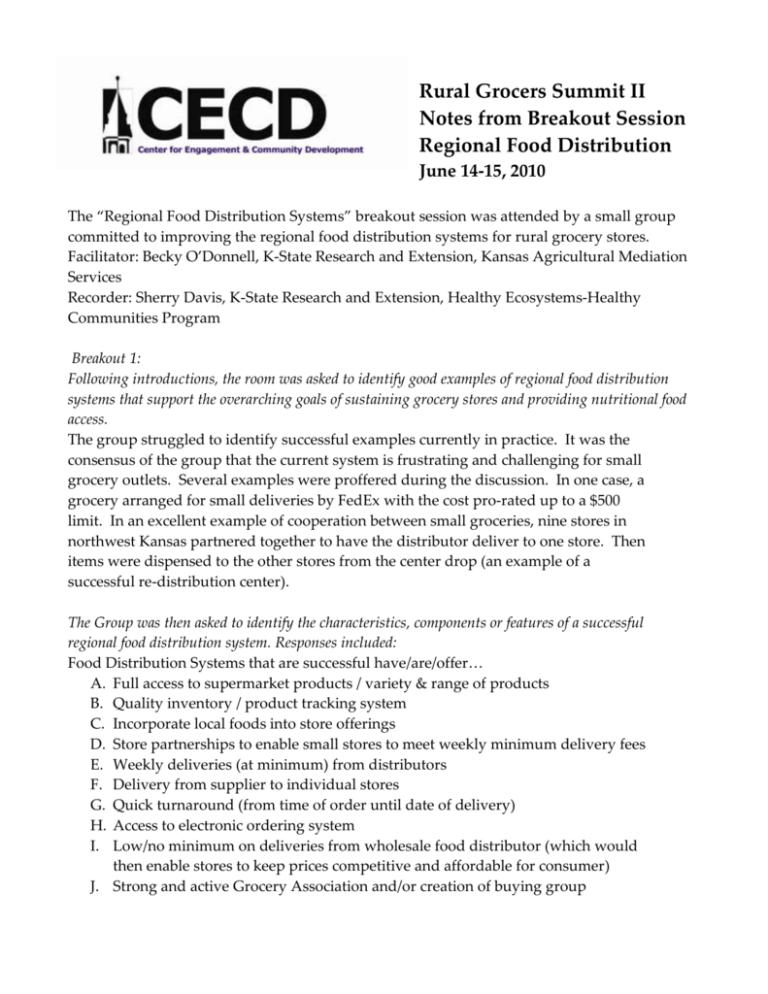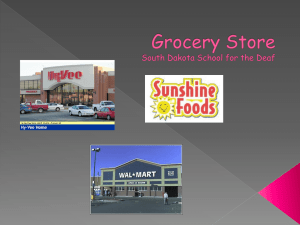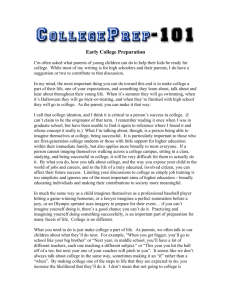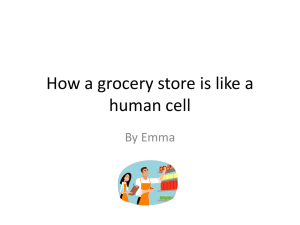Local Government - Rural Grocery Initiative
advertisement

Rural Grocers Summit II Notes from Breakout Session Regional Food Distribution June 14-15, 2010 The “Regional Food Distribution Systems” breakout session was attended by a small group committed to improving the regional food distribution systems for rural grocery stores. Facilitator: Becky O’Donnell, K-State Research and Extension, Kansas Agricultural Mediation Services Recorder: Sherry Davis, K-State Research and Extension, Healthy Ecosystems-Healthy Communities Program Breakout 1: Following introductions, the room was asked to identify good examples of regional food distribution systems that support the overarching goals of sustaining grocery stores and providing nutritional food access. The group struggled to identify successful examples currently in practice. It was the consensus of the group that the current system is frustrating and challenging for small grocery outlets. Several examples were proffered during the discussion. In one case, a grocery arranged for small deliveries by FedEx with the cost pro-rated up to a $500 limit. In an excellent example of cooperation between small groceries, nine stores in northwest Kansas partnered together to have the distributor deliver to one store. Then items were dispensed to the other stores from the center drop (an example of a successful re-distribution center). The Group was then asked to identify the characteristics, components or features of a successful regional food distribution system. Responses included: Food Distribution Systems that are successful have/are/offer… A. Full access to supermarket products / variety & range of products B. Quality inventory / product tracking system C. Incorporate local foods into store offerings D. Store partnerships to enable small stores to meet weekly minimum delivery fees E. Weekly deliveries (at minimum) from distributors F. Delivery from supplier to individual stores G. Quick turnaround (from time of order until date of delivery) H. Access to electronic ordering system I. Low/no minimum on deliveries from wholesale food distributor (which would then enable stores to keep prices competitive and affordable for consumer) J. Strong and active Grocery Association and/or creation of buying group K. L. M. N. O. P. Ability for small stores to special order items Cash & carry re-distribution centers “Live credits” (ability for drivers to give on the spot credits) Access to regular, quality fresh/perishable products Frequent perishable deliveries Ability to supplement perishable deliveries from wholesale food distributors with reliable local food suppliers Q. Broad-based wholesale product selection from wholesale food distributors The group was then asked, “Identify key issues and challenges that need to be addressed in order to reach a strong and successful regional food distribution system that supports the overarching goal? Suggestions Included: Meeting the minimum weekly order requirement for delivery Meeting minimum order (sales level) in order to receive price break (volume discount) Rebate amount/minimum order amount Frequency of deliveries Timely deliveries/regular delivery of fresh produce/products Fuel cost/surcharge/transportation costs Delivery cost Alternative sources if unable to meet minimum with main distributor Start up cost for new distribution centers Self pickup from distributor Local quality versus Big Box store prices/competition with big box stores’ prices and variety of brands/products Point of sale ordering (P.O.S.) Availability and access to local/regional agricultural products; fresh cut meats; produce and perishables Incorporating local foods/Kansas products into distribution system Having to limit product brand/range of selection due to low customer purchase volume/demand Challenge facing stores regarding lack of customer base to prevent perishable waste (Sales volume) Lack of a strong and active Grocers Association Availability of resource information to assist stores Pooling buying power/resources Truck driver’s legal constraints (hours on road, weight, etc.) Cost of distribution from the distributors perspective An overall cost effective system Breakout #2 The group reviewed the key issues and challenges developed during Breakout #1. The group identified the top three issues that they felt were most important to be addressed and acted upon which would help Kansas sustain small grocery stores (especially in rural areas) and allow access to fresh, nutritional food as well as a broad enough range of products and brand to compete successfully in the marketplace. 1) Grocery stores’ ability to consistently meet minimum weekly order requirement set by distributor. (If minimum if not met, the distributor will not stop and make a delivery that week.) 2) Frequency of deliveries. 3) Ability to incorporate local foods and Kansas products into regional distribution system. The group broke into three sub-groups. Each sub-group concentrated on one of the three issues, according to their interest and experience. Sub-Group #1 - Minimum weekly order. Key Discussion Points: This sub-group felt the number one challenge and barrier to the success and sustainability of a rural grocery store was being able to meet the wholesale food distributor’s minimum weekly order dollar amount. Ideally, the system would allow: Full access to supermarket products Selection offered customers would include local foods Distributor would deliver to each individual store Cost to grocery would be affordable, thus allowing products to be affordable for customers Keeping those ideals in mind, the sub-group discussed action steps and areas where research and support is desired. Action Steps Needed: Weekly minimums have consistently risen over the last four years. Grocery stores need to form partnerships in order to meet minimums and have consistent, regular deliveries Establish additional redistribution centers o Idea of Cooperatively owned redistribution centers o “Cash and Carry” centers Establish order on-line with drop off sites (sited example of Nebraska Food Cooperative) In order to meet their customer needs and stay viable, groceries need full access dynamic general store with variety of products and brands available (“one-stopshopping”) Possible Areas/Ideas for Future Research or Areas in Which Assistance is Needed: Establish redistribution centers and co-ops; coordinate 3rd party transportation to smaller stores; Research costs & feasibility Develop a Co-op map Assistance regarding how communities can increase customer support for shopping at rural groceries (as opposed to traveling to nearby towns and purchasing at large box stores) Sub-Group #2 - Frequency of Deliveries. Key Discussion Points: This sub-group identified regular delivery of perishables the most important issue to retailers. If the grocery is able to offer quality perishables can make a real point of difference with customers (both in dollars spent and frequently of shopping). Would the supplier be willing to offer additional perishable deliveries? This may result in the retailer experiencing additional freight expense. However, the group felt the product margin would allow for additional expense. Frequency of delivery would improve quality of product available to the customer. However, would (or could) the retailers be willing to pay an additional cost for increase in frequency. A multi-market concept (i.e., clothing, food, True Dollar store, and hardware) Possible Areas/Ideas for Future Research or Areas in Which Assistance is Needed: Explore the feasibility of additional deliveries with wholesaler Assistance from wholesaler to coordinate/arrange deliveries in order to increase frequency Educate grocery stores on how the distribution centers obtain their product selection Assist stores in exploring all product available in their areas How can secondary suppliers contract with warehouses/distributors How can the local farmer/producer/grower connect with the distributor Sub-Group #3 - Ability to incorporate local foods and Kansas products into the regional distribution system. Key Discussion Points: Processed products are easier to ship and market. However, desire to have quality/quantity of fresh/perishables available for customers. Distribution pathways are a challenge. Those dealing with large volumes ship to distribution point. Challenge of small groceries being able to tap into local sources/growers to offer their products. Action Steps: Identify growers and brokers Meet distributor needs on amount and timeliness for quantities to distribute to groceries Buying clubs – may become distributor Stakeholders to Involve: Grocery store owners/managers Specialty growers Local producers/growers Community Wholesale Food Distributors Additional Ideas: Have sales of other items to make up minimum requirement so they can afford to get local foods in season “Buying Parties” or other special events to education/draw attention Time Frame: Immediately contact local institutions Distributors can assist groceries to match up with customs Possible Areas/Ideas for Future Research or Areas in Which Assistance is Needed: Way to hook up growers to get cohesive delivering to distributors Hook up growers with distributors to reach cohesive delivery to groceries Research as to how to replace customers’ choice for fast, processed food with fresh fruits, fresh vegetables, Kansas products, and local foods Producers need to know what is out there/available as much as buyers desire that information. Set up “Food Shows” in March or September to highlight selection and network Develop a “Tool Box”: 10 things you can do to get your product onto the shelf (into the grocery store) Most important message(s) to be shared by the Group: From Sub-Group #1: Partner together in order to meet minimum dollar requirement for weekly deliveries from wholesale food distributors Develop a strong and active Grocery Association From Sub-Group #2: Have CECD invite Wholesalers/Distributors to present at the next Rural Grocers Summit. Important for mutual understanding of the challenges, limitations, costs, trucking issues, etc, that the distributor is facing. From Sub-Group #3 * Develop a “Tool Box” – “10 Things You Can Do To Get Your Product into the Store” Important Partners in building campaigns K-State (researchers, CECD) Grocery Association – Need to work together Communities working with groceries to create sustainable communities and support of local businesses





